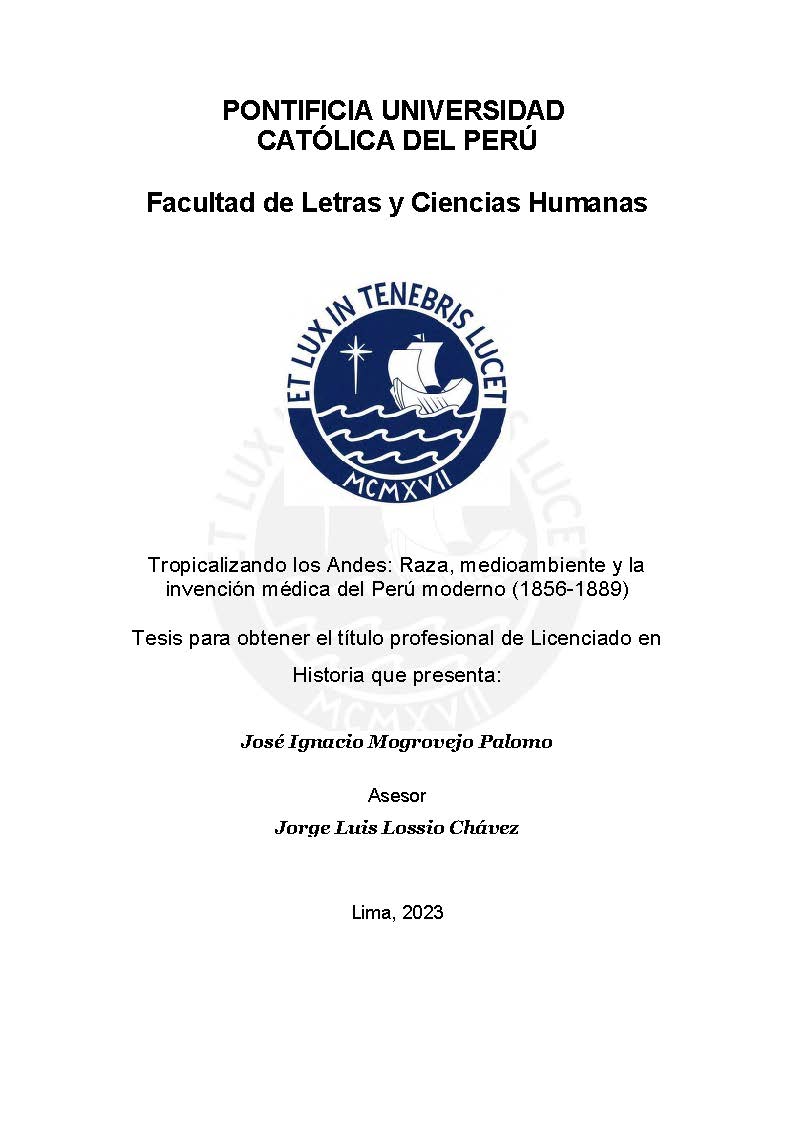| dc.contributor.advisor | Lossio Chávez, Jorge Luis | |
| dc.contributor.author | Mogrovejo Palomo, José Ignacio | |
| dc.date.accessioned | 2023-02-13T23:29:35Z | |
| dc.date.available | 2023-02-13T23:29:35Z | |
| dc.date.created | 2023 | |
| dc.date.issued | 2023-02-13 | |
| dc.identifier.uri | http://hdl.handle.net/20.500.12404/24257 | |
| dc.description.abstract | El propósito de esta tesis es analizar la relevancia de los trabajos e investigaciones de
geografía médica producidos en Lima en la construcción de una imagen de “atraso” para
la Sierra y de su población. Asimismo, busca saber cómo esto sirvió de justificación para
relegarlos a ser objetos científicos como parte de una aspiración de la élite médica por
alcanzar el “progreso” durante la segunda mitad del siglo XIX. Mediante la revisión de
monografías, artículos de análisis, discusiones y tesis de medicina, sostenemos que se
formó un imaginario medioambiental criollo desde la medicina para imponer una
condición de atraso e incivilización al espacio andino y la población indígena. Sin
embargo, usando una mirada post-constructivista de la ciencia y los aportes de la historia
poscolonial de la medicina, planteamos que esta figura no fue monolítica, ya que la
identidad racializada y patologizada de la población indígena y los Andes se articuló en
un sentido relacional. Es decir, debido a su lugar dentro de un ensamblaje socio-ecológico
del país, sus diferentes interacciones con los médicos, las bacterias y los insectos fueron
determinantes en la concepción del Perú moderno. | es_ES |
| dc.description.abstract | The purpose of this dissertation is to analyze the relevance of Lima-based medical
geography works and research in the construction of a “backwardness” image for the
Highlands and its population. Also, it looks to know how this justified their relegation as
objects of science, as part of the medical elite aspiration to reach “progress” during the
second half of the nineteenth-century. By reviewing monographs, short essays, discussions
and medical dissertations, we argue that a creole environmental imaginary was formed from
medicine to impose a back warded and uncivilized condition to the Andean space and the
indigenous population. However, by using a post-constructivist view of science and some
ideas from the postcolonial history of medicine, we argue that this figure wasn’t monolithic.
This was because the racialized and pathologized identity of both the indigenous population
and the Andes was articulated in a relational sense. In other words, given their place inside
a socio-ecological assemblage of the country, their diverse interactions with the physicians,
bacteria and insects were essential in the conception of Modern Peru. | es_ES |
| dc.language.iso | spa | es_ES |
| dc.publisher | Pontificia Universidad Católica del Perú | es_ES |
| dc.rights | info:eu-repo/semantics/openAccess | es_ES |
| dc.rights.uri | http://creativecommons.org/licenses/by-sa/2.5/pe/ | * |
| dc.subject | Geografía médica--Perú--Lima | es_ES |
| dc.subject | Enfermedades--Perú--Historia--Siglo XIX | es_ES |
| dc.subject | Patología--Andes, Región (Perú)--Siglo XIX | es_ES |
| dc.title | Tropicalizando los Andes: Raza, medioambiente y la invención médica del Perú moderno (1856-1889) | es_ES |
| dc.type | info:eu-repo/semantics/bachelorThesis | es_ES |
| thesis.degree.name | Licenciado en Historia | es_ES |
| thesis.degree.level | Título Profesional | es_ES |
| thesis.degree.grantor | Pontificia Universidad Católica del Perú. Facultad de Letras y Ciencias Humanas | es_ES |
| thesis.degree.discipline | Historia | es_ES |
| renati.advisor.dni | 10002555 | |
| renati.advisor.orcid | https://orcid.org/0000-0001-9883-2048 | es_ES |
| renati.author.dni | 70614615 | |
| renati.discipline | 222066 | es_ES |
| renati.juror | Cosamalon Aguilar, Jesus Antonio | es_ES |
| renati.juror | Lossio Chavez, Jorge Luis | es_ES |
| renati.juror | Seiner Lizarraga, Lizardo Alfredo | es_ES |
| renati.level | https://purl.org/pe-repo/renati/level#tituloProfesional | es_ES |
| renati.type | https://purl.org/pe-repo/renati/type#tesis | es_ES |
| dc.publisher.country | PE | es_ES |
| dc.subject.ocde | https://purl.org/pe-repo/ocde/ford#6.01.01 | es_ES |







